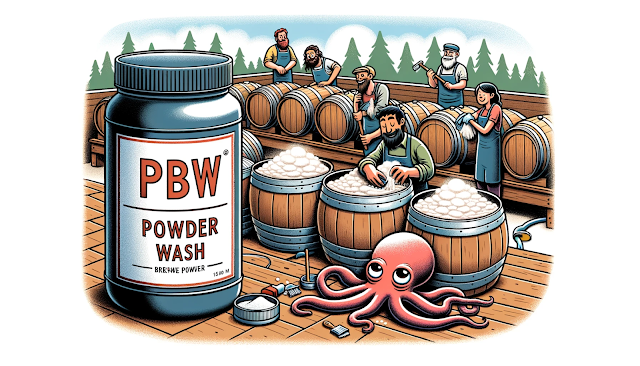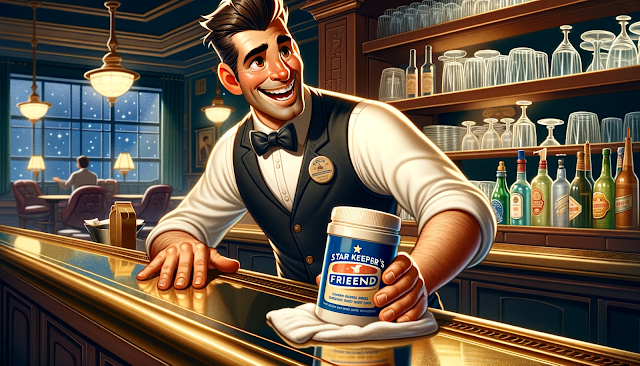Beer brewing is an intricate art that combines scientific precision with culinary creativity. As brewers embark on this alchemical journey, turning simple ingredients into delectable brews, a foundational principle reigns supreme: cleanliness is paramount. The meticulous maintenance of impeccably clean and sanitized equipment is not merely a suggestion; it is an absolute necessity for consistently producing high-quality beer.
Any contamination, regardless of its microscopic scale, can introduce unwanted microorganisms that drastically alter the taste, aroma, and even the safety of the final product. Enter sodium percarbonate—a powerful cleaning agent that offers brewers not only a potent solution for removing grime but also a pathway to greater confidence in their sanitation practices.
In its convenient powdered form, sodium percarbonate readily dissolves in water, making it an accessible and efficient cleaning agent for brewers at all stages of experience. This essay will delve into the properties, advantages, and crucial pH considerations when utilizing sodium percarbonate in the beer brewing process. By thoroughly understanding and skillfully applying this compound, while being mindful of pH, brewers can ensure their equipment remains in pristine condition, consistently paving the way for brewing success.
What is Sodium Percarbonate and its pH Impact?
Sodium percarbonate, a compound often hailed as a brewer's reliable cleaning ally, is a chemical adduct of sodium carbonate (soda ash) and hydrogen peroxide. When this white powder dissolves in water, it undergoes a chemical reaction that releases hydrogen peroxide (H₂O₂) and sodium carbonate (Na₂CO₃), both of which contribute to its cleaning and sanitizing prowess.
The resulting solution is alkaline due to the presence of sodium carbonate, typically exhibiting a pH in the range of 10-11 at typical cleaning concentrations. This elevated pH is a key factor in its effectiveness as a cleaner, as alkaline solutions excel at saponifying fats and breaking down organic matter commonly found in brewing residues.
Why Choose Sodium Percarbonate, Considering pH?
Sodium percarbonate presents several compelling benefits for brewers who are also conscious of maintaining appropriate pH during cleaning. Its advantages extend beyond mere cleaning power to encompass user-friendliness and environmental considerations.
Simplicity and efficiency at an alkaline pH: Sodium percarbonate is straightforward to use and highly effective at removing a wide array of brewing soils, including dried wort, krausen residue, and hop oils, thanks in part to its alkaline pH. The elevated pH helps to loosen these deposits, while the released oxygen provides a scrubbing action at a microscopic level.
"No-rinse" with pH awareness: While often labeled "no-rinse," the alkaline nature of the solution means that careful consideration of potential pH impact on subsequent brewing processes is wise. Residual alkalinity, if not properly addressed, could slightly raise the pH of the mash or wort in the next brew. A final rinse with acidified water (like a dilute Star San solution) can neutralize any remaining alkalinity and provide an additional layer of sanitation.
Cost-effective alkaline cleaning: Compared to some specialized brewing cleaners, sodium percarbonate is generally more economical, especially when purchased in bulk. Its effectiveness at an alkaline pH allows brewers to achieve thorough cleaning without necessarily resorting to more expensive, proprietary formulations.
Beyond Brewing: An Alkaline Household Helper
The cleaning capabilities of sodium percarbonate, driven by its alkaline pH and oxidizing power, extend into common household applications. It is a frequent component of laundry detergents and other cleaning products.
Its inclusion in "oxygen-boosting" laundry detergents highlights its ability to tackle organic stains and brighten fabrics through oxidation and the alkaline environment it creates in the wash water.
Understanding the Application, Benefits, and pH in Brewing
Sodium percarbonate acts as a dual-action agent in the brewery, both cleaning and sanitizing through its alkaline nature and the release of active oxygen. The alkaline pH helps to break down the chemical bonds in organic soils, making them easier to lift from surfaces.
The oxidizing power of the released hydrogen peroxide further aids in sanitization by disrupting the cellular functions of many microorganisms. However, for true sanitization, adequate concentration and contact time are crucial, and relying solely on the sanitizing effect of sodium percarbonate without a dedicated sanitizer might be insufficient for critical applications.
Step-by-Step Guide to Using Sodium Percarbonate with pH Considerations
Prepare your equipment for alkaline cleaning: Begin by ensuring your brewing equipment is free of any large, loose debris. A preliminary rinse with warm water will remove easily dislodged material, allowing the alkaline sodium percarbonate solution to work more effectively on the remaining residues.
Mix the alkaline solution: To activate the sodium percarbonate, dissolve the recommended amount (typically 1-2 tablespoons per gallon of hot water) in a clean vessel. The heat enhances the release of oxygen and the overall cleaning action of the alkaline solution.
Soak for thorough alkaline cleaning: Submerge your brewing equipment completely in the alkaline sodium percarbonate solution and allow for a sufficient soaking period, often several hours or overnight for stubborn soils. This extended contact time allows the alkaline solution to penetrate and break down even dried and adhered organic matter.
Rinse with pH awareness: While often described as "no-rinse," it is prudent for brewers to rinse thoroughly with clean water after using sodium percarbonate. For added security against any residual alkalinity affecting the subsequent brew's pH, a final rinse with a diluted acid-based sanitizer (like Star San, at its recommended low pH) is a best practice.
Sodium Percarbonate: When and Why to Use It, Mindful of pH
Sodium percarbonate is a valuable cleaning tool for brewers in various situations, and understanding the pH of its solutions helps optimize its use. Recognizing these scenarios allows for its strategic implementation in a cleaning regimen.
Preparing for optimal yeast health at a balanced pH: When brewing high-attenuation or high-ABV beers, a clean and sanitized fermentation environment with a stable pH is vital for robust yeast performance. Sodium percarbonate's alkaline cleaning action helps achieve this, but ensuring no residual alkalinity remains that could impact fermentation pH is crucial.
Water quality and cleaning pH: Regardless of your brewing water's mineral content, using sodium percarbonate at its inherent alkaline pH effectively removes organic buildup that could harbor contaminants. However, brewers should be aware that the alkalinity of the cleaning solution itself is separate from the mineral composition of their brewing water.
Cleaning after adjunct use with alkaline power: Beers brewed with high amounts of sugars or adjuncts can leave sticky residues. The alkaline pH of sodium percarbonate solutions excels at breaking down these carbohydrate-rich deposits, ensuring a clean surface for subsequent sanitation.
Maintaining pH balance beyond beer: For cleaning equipment used in winemaking, cider making, or mead production, where different pH ranges are optimal for fermentation, the alkaline residue from sodium percarbonate must be thoroughly removed or neutralized to avoid impacting the pH of these beverages.
Sodium Percarbonate Alternatives for Brewers: pH Considerations
While sodium percarbonate is a popular alkaline cleaner, brewers have other options, each with its own pH characteristics. Understanding these differences is important for informed decision-making.
Household Alternatives and their pH: Oxygen-based laundry detergents containing sodium percarbonate will also have an alkaline pH. Non-scented varieties are preferable, followed by a thorough rinse, ideally with an acidified solution, to counteract the alkalinity.
Caustic soda (sodium hydroxide) is a highly alkaline cleaner with a very high pH and requires extreme caution. Its use necessitates thorough rinsing and potential neutralization to prevent any pH imbalances in future brews. Acid-based cleaners, on the other end of the pH spectrum, are also available for specific cleaning tasks like removing mineral buildup.
Pre-Packaged Brewing Solutions with defined pH: Many commercial brewing cleaners are formulated with specific pH ranges in mind for optimal cleaning without harming equipment or affecting subsequent brews. Following the manufacturer's instructions regarding concentration and rinsing is crucial for these products.
Understanding Sodium Compounds and pH
It's important for brewers to distinguish between different sodium-based compounds commonly encountered. Sodium carbonate (soda ash) is even more alkaline than a dissolved sodium percarbonate solution and can be harsh on some materials, requiring careful use and thorough rinsing.
Sodium bicarbonate (baking soda) has a lower alkaline pH than sodium percarbonate and is not as effective for heavy-duty cleaning of brewing equipment. Its mild alkalinity might not be sufficient for removing tough brewing residues.
Additional Tips for Brewers: pH-Conscious Cleaning
When using sodium percarbonate to clean a wooden deck, remember its alkaline nature might affect the wood over time with prolonged exposure at high concentrations. Always test in an inconspicuous area first and rinse thoroughly.
Before capping your beer bottles, ensure they are not only visibly clean but also free of any alkaline residues from cleaning solutions. A final rinse with a low-pH sanitizer provides peace of mind that the beer's pH and stability will not be compromised.
Safety and Efficacy: Maintaining pH Balance
Always prioritize safety when using any cleaning chemical. Wear appropriate protective gear, such as gloves and eye protection, as alkaline solutions can be irritating. Store chemicals safely away from children and pets.
Ensure your chosen cleaning method, using sodium percarbonate or an alternative, effectively removes contaminants without leaving residues that could affect the pH or flavor of your beer. A clean and pH-neutral brewing environment is key to consistent brewing success.
The Brewer's Conclusion: Mastering Cleanliness and pH for Brewing Excellence
Sodium percarbonate stands out as a valuable and cost-effective tool for brewers seeking a powerful alkaline cleaner for their equipment. However, a knowledgeable brewer understands the importance of pH in both the cleaning process and its potential impact on subsequent brewing steps.
By carefully considering the alkaline nature of sodium percarbonate solutions and implementing appropriate rinsing or neutralization steps, brewers can harness its cleaning power while maintaining the crucial pH balance necessary for consistently brewing high-quality beer (a fundamental aspect of successful brewing).












